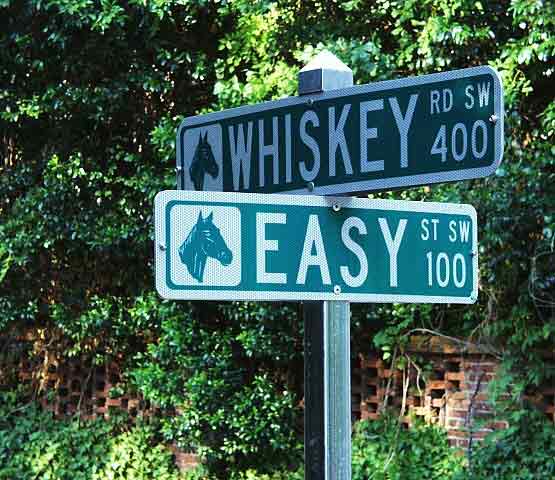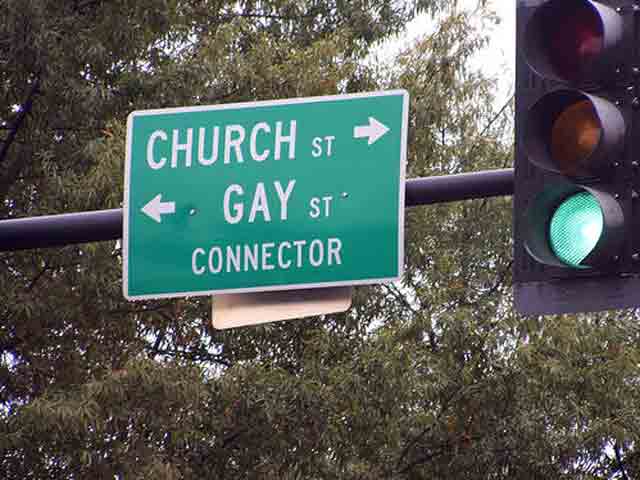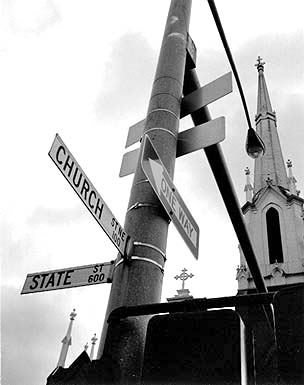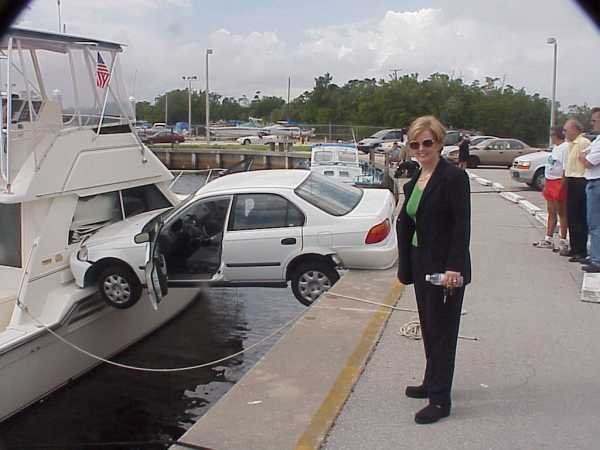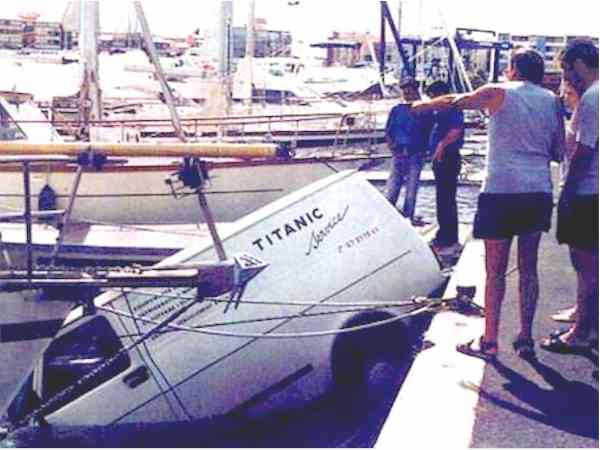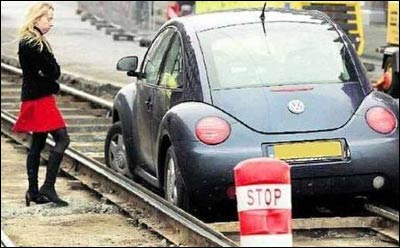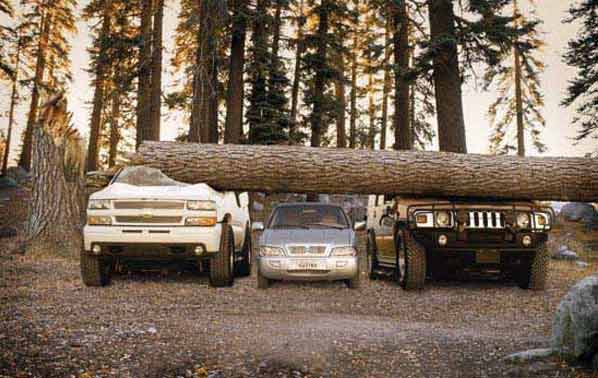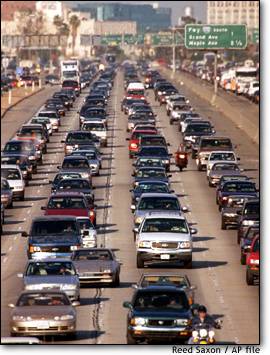Let's Go for a Drive
A Brief Sketch of the History of Street Naming in AmericaAt any street corner the feeling of absurdity can strike any man in the face. - Albert Camus The street to obscurity is paved with athletes who can perform great feats before friendly crowds. - George Allen
Source: aiken.net by Lawrence Kestenbaum In the earliest days of urban development in what's now the US, streets tended to be named for landmarks, like Church, Market, Monument, Canal, Wall, Court, Dock, et cetera, obvious topographic or hydrological features like Hill or Water, or references to the street's position like East or Middle. Often major streets would be named for symbols of power and authority, like State or King or Queen; after the American Revolution, the names of heroes and leaders like Washington and Jefferson also served this role. The whole concept was that a "street" was an urban feature (roads outside cities were subject to different rules and usually not named at all), and the word "street" tended to be an assumed descriptor rather than part of the name. Hence you see references to "Church street" or "Washington street" as opposed to today's "Church Street" or "Washington Street". Alleys, where they had names (for example, in Baltimore) were often named for the landowner, and had a possessive, like "Lenoir's alley". There were important exceptions (the planners of New York's numbered streets and Philadelphia's tree names were ahead of their time), but in most American cities that was the pattern until around 1850. It was then that an important cultural change took place which affected everything from gardening to literature: a shift in the view of Nature. Before this, Nature was seen almost universally (among Americans) as hostile, howling wilderness to be conquered. The new view took account of Nature as offering beauty, safety and cleanliness in contrast with the filth and crowding of the early industrial city. It was a romantic vision of picturesque English countryside, with trees and buildings scattered about in "natural" form rather than lined up in rigid rows. There were many strands to this, all interrelated. One was architectural: a change from the cool, rational, ordered (and urban) Greek Revival style to the picturesque, romantic, asymmetric Gothic Revival, a movement inspired by John Ruskin and A W N Pugin in England and carried in the US by A J Davis (architect of Lyndhurst, a famous Gothic mansion overlooking the Hudson River in Tarrytown NY, now a museum). Another strand was the Rural Cemetery Movement, which called for replacement of crowded and unsanitary urban churchyards with a spacious, non-denominational "park" outside of town, with grave monuments arrayed among plentiful trees and natural features: Mount Auburn Cemetery in Cambridge, Massachusetts was one of the first and greatest models of this. Closely related was the new art of "naturalistic" landscape design, as practiced by Frederick Law Olmsted in Central Park (New York City) and other places. And the ideal of what we now call suburbia was born in this era: the notion of ordinary houses having lawns and trees around them. Even as rural life was idealized, urbanization was proceeding rapidly. New cities were being laid out from Maine to California and older ones were expanding. But the new aesthetic had an impact on what all those new streets were called. It was at this time that the names of tree species suddenly became the dominant choices for street names: the leader among streets named in the 1850's is Oak, followed closely by others such as Elm, Maple, Pine, Walnut, and so on. After the Civil War, expansion of urban settlements was even more rapid. Most often these were "additions" to existing communities, done almost entirely by private real estate operators. Subdivisions with names like "Raymond H Chase's Addition to the City of Springfield" were ubiquitous, and most often the streets were named for the developers and their associates. Tree names were still being used, but during this period the percentage of "surname" streets soared. Meanwhile, especially out West where whole new cities were still being started, the creation of organised systems with grids of numbered or lettered streets was in vogue. There is an excellent book about this by John Reps, titled The Forgotten Frontier: Urban Planning in the American West Before 1890. Some time around 1880, the word "street" was displaced by "avenue"; the percentage of "streets" fell steadily and "avenues" rose just as quickly. By the turn of the century only a small percentage of the new thoroughfares being added had "Street" in their names.
Nashville Source: flickr.com In established areas, the growth of urban settlement took place along streetcar lines. In many older cities, you can recognise the major street where the streetcar line ran, crossed by many closely spaced parallel streets with long blocks of houses on narrow lots. Horsecars and eventually electric streetcars made it possible for even working people to commute miles from the centre of town. On this topic, you might be interested in the book Streetcar Suburbs, by Sam Warner. Then, in the 1890 - 1910 period, came another intellectual and architectural revolution: the City Beautiful Movement. The Columbian Exposition in 1893 was composed of monumental white classical buildings arranged along a broad mall; this became a new, orderly vision for what cities could be like (in stark contrast to the crowded and messy reality). A leader in this was the architect Daniel H Burnham, who is famed for supposedly saying "Make no little plans; they have no magic to stir men's blood." Burnham had in mind the kinds of things that Haussman had done in Paris, sweeping aside whole parts of town to build wide boulevards and monuments with long vistas and colonnades. Classically inspired architecture surged back into vogue, as did the "colonial" styles of the 18th century. Words like "boulevard" and "park" and "court" became commonplace in street names of this period. More than that, the ambitions people had for their cities were expressed in the newly highfalutin' street names, like Majestic Terrace, or Buckingham Boulevard. Naming several streets in a subdivision for American states (that is, states other than the one where the subdivision was located) took place most frequently at the turn of the century. For the first time, the developers started to choose street names with an eye toward shaping the image of their subdivisions, a practice that continues to this day. After World War I, especially, came the automobile, and land use patterns changed drastically. Starting in the 1920's, "avenue" as a street descriptor was displaced by "drive"; by 1980, it was uncommon to see a subdivision street named anything other than "drive". English baronial imagery for new subdivisions was typical in the 1920's, along with Tudor architecture for suburban houses. But almost anything that evoked suburbia was used. The suffixes "-wood" and "-land" were tacked on to almost anything to coin street names. Floral names, names of famous colleges and universities, English counties, world cities - all inspired street names. Developers in larger metro areas had to be especially creative. But the bottom line was the setting of a positive image for the development. The use of personal names (ordinary, un-picturesque personal names, I mean, like Macmillan or Maynor or Kestenbaum or Grissom) fell precipitously. Another important and little-appreciated influence came from the rules imposed by the federal home financing agencies like the FHA. I'm not completely clear on the details, but the FHA had rules about how new subdivisions had to be planned in order to be eligible for FHA home financing. One requirement was for "curvilinear streets". So, especially after World War II, practically every subdivision in America had curvilinear streets which could easily be described as "drives". Written and maintained by Lawrence Kestenbaum, creator of The Political Graveyard politicalgraveyard.com Revised 14 April 2004 Source: potifos.com Kestenbaum's is an entertaining site and there is loads more information to be found there. Please visit.
Source: wefn.org photo essays by Herman Krieger
What is the difference between a "street" and a "road"? The terms may frequently apply to exactly the same thing. However, 'road' is a general term, whereas 'street' is narrower in sense and chiefly urban in application: a street typically has buildings on either side, and is paved or metalled Source: askoxford.com
Some of the Problems Associated with Parking Near Water...
Source: left thesun.co.uk sent to them Chris Vickers; right alphacouriers.freeserve.co.uk
Source: cynical-c.com
Or Train Tracks...
Or Big Trees...
Mass Transit Hysteria: The Opposite of Progressby P J O'Rourke [Extract] There are just two problems with mass transit. Nobody uses it, and it costs like hell. Only 4% of Americans take public transportation to work. Even in cities they don't do it. Less than 25% of commuters in the New York metropolitan area use public transportation. Elsewhere it's far less - 9.5% in San Francisco-Oakland-San Jose, 1.8% in Dallas-Fort Worth. As for total travel in urban parts of America - all the comings and goings for work, school, shopping, et cetera - 1.7 % of those trips are made on mass transit. Then there is the cost. Less obviously, there's all the money spent locally keeping local mass transit systems operating. The Heritage Foundation says, "There isn't a single light rail transit system in America in which fares paid by the passengers cover the cost of their own rides." Heritage cites the Minneapolis "Hiawatha" light rail line, soon to be completed with $107 million from the transportation bill. Heritage estimates that the total expense for each ride on the Hiawatha will be $19. Commuting to work will cost $8,550 a year. If the commuter is earning minimum wage, this leaves about $1,000 a year for food, shelter and clothing. Or, if the city picks up the tab, it could have leased a BMW X-5 SUV for the commuter at about the same price. Source: opinionjournal.com Wednesday 16 March 2005
Ignoring a Few Thingsby Ken Taylor The fact is that no major transportation system is paid for entirely by its users. Building and maintaining roads is hugely expensive, yet in very few cases do users pay for them. They are mainly paid for by public funds and are a much greater portion of the transportation bill than rail. The same goes for air travel. The federal government has invested billions in supporting the airlines and their infrastructure. Mr O'Rourke must know this, he just chooses to ignore it because the facts aren't so funny. So, if the true cost of other forms of transportation was accurately calculated, we could have a real debate about their relative merits. But those on the right don't really like facts or debate, and because rail is best suited to more densely populated areas, which tend to be more liberal, would like to kill it, unless, of course, it takes the form of roller coaster or water slide. Ken Taylor lives in Madison, Wisconsin Source: opinionjournal.com
Highway MysteriesScientists Search for the Answers to Phantom Jams, Other Headaches
by Sharon Begley If you plan to hit the roads like the zillions of other drivers this holiday weekend, Avi Polus has a word of advice: patience. A transportation engineer at Technion-Israel Institute of Technology in Haifa, Profeessor Polus' concern isn't drivers' collective blood pressure but traffic flow. Like the growing number of other engineers and physicists who are hubcap-deep in the science of traffic, he is determined to explain infuriating mysteries such as phantom traffic jams (There's no bottleneck or accident at the front of this jam, so why weren't we moving?) and why a brief drop in volume can, paradoxically, trigger a long-lasting traffic jam. Impatience on 2-lane roads actually improves traffic flow, as antsy drivers pass slowpokes rather than letting a convoy form. On highways, however, "passing, aggressive behaviour and lane changing is greatly detrimental to the flow," says Professor Polus. The reason is that chronic lane changing simulates the "weaving section" of a highway.*mnsp; If an off-ramp lies just beyond an on-ramp, entering drivers merge left (assuming ramps are on the right) and exiting drivers merge right, causing traffic to crisscross like mobile braids. When, in heavy traffic, many drivers change lanes again and again, trying to find the one that is moving faster, the same weaving effect kicks in, reducing the capacity of that section of road. "Weaving is the worst condition for traffic flow," says Professor Polus. Because drivers in heavy traffic brake when a car pulls into their lane, and because it takes time to get back up to speed, there are larger and constantly changing gaps between vehicles. That invites yet more cars to change lanes, propagating a wave of stop-and-go traffic that cuts the number of cars in a stretch of road by about 10%, calculates Professor Polus, who will present his work at the 16th International Symposium on Transportation and Traffic Theory at the University of Maryland. That may not sound so dire, but in rush hour the result is a 5-mile backup, his calculations show. In congestion, be content with the lane you're in. More and more scientists are modelling traffic with equations from the branch of math called nonlinear dynamics, which describes systems that suddenly jump from one state to another. Like water that suddenly freezes, flowing traffic can spontaneously seize up, beginning at a single point of crystallization (the idiots who braked to rubberneck) and causing a wave of high density to spread backward (bumper-to-bumper lines). Lane closures, on ramps, uphill, chronic lane changing and other "inhomogeneities" in traffic flow can all trigger a density wave, Martin Treiber of Dresden University of Technology has shown in mesmerising simulations (www.traffic-simulation.de). One result can be "phantom" jams, which occur so far upstream of the bottleneck that the congestion there has long cleared by the time drivers at the back of the pack reach it. As a result, they never see the snafu that flipped smooth flow into a stop-and-go mess. By one estimate, ¾ of traffic jams are phantoms. Carlos Daganzo of the University of California, Berkeley, was puzzled by what highway sensors showed: When congested traffic forms upstream of a bottleneck, the rate at which cars at the front leave the congested area decreases. "It's as if, when a line forms at the popcorn stand, the server slows down, so people leave with their popcorn at a slower rate just because there are more people waiting," he says. Yet the counterintuitive effect is seen time and again, and in a recent study he and colleagues figured out why. The congestion causes cars to jockey across lanes, ever on the lookout for the faster one. Lane changing increases the gaps between cars, as drivers slow down when someone barges in front of them. Bigger gaps means fewer cars per second leaving the front of the jam. If that seems counterintuitive, consider that briefly reducing volume can trigger a stop-and-go wave. Within the region with suddenly fewer cars, perhaps because a long funeral cortege just exited, the emptier road entices drivers to speed up ("Open road - yes!"). But sooner or later, Professor Treiber notes, these drivers catch up to a denser, slower-moving region. The ensuing braking can trigger the dreaded density wave. Most jams occur way before a road reaches its capacity, and the culprits are all around you. Even in heavy but moving traffic, inhomogeneities would have much less effect if drivers had faster reaction times. When merging traffic causes the driver in front of you to brake, you do so as well, unless you enjoy fender benders. But because braking takes time, the gap between you and the car ahead shrinks, explains Professor Treiber. You slow even further until the gap reaches a size you are comfortable with. Result: You are now traveling even more slowly than the car whose braking triggered the stop-and-go wave in the first place. The car behind you does the same, and the effect propagates backward, often for miles. You can lessen this effect, however. Professor Treiber suggests looking a few cars ahead so you know when and how much to brake. "If you brake just in time, you can usually safely brake less," he says, "which improves the flow." Consider it a good deed. Source: Charleston Gazette (West Virginia) P3B 3 July 2005 © 2005 Charleston Newspapers originally from The Wall Street Journal 5 July 2005
For more articles, tests, film studies and visual amusements click the "Up" button below to take you to the Index page for this Intellectual and Entertaining section. |
 Animals
Animals Animation
Animation Art of Playing Cards
Art of Playing Cards Drugs
Drugs Education
Education Environment
Environment Flying
Flying History
History Humour
Humour Immigration
Immigration Info/Tech
Info/Tech Intellectual/Entertaining
Intellectual/Entertaining Lifestyles
Lifestyles Men
Men Money/Politics/Law
Money/Politics/Law New Jersey
New Jersey Odds and Oddities
Odds and Oddities Older & Under
Older & Under Photography
Photography Prisons
Prisons Relationships
Relationships Science
Science Social/Cultural
Social/Cultural Terrorism
Terrorism Wellington
Wellington Working
Working Zero Return Investment
Zero Return Investment